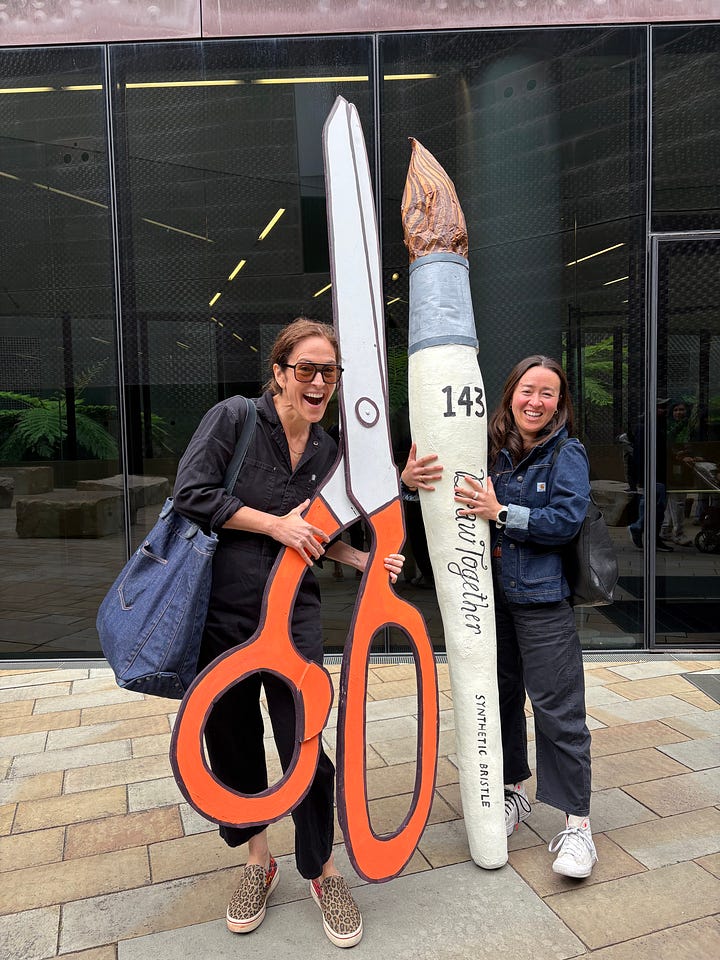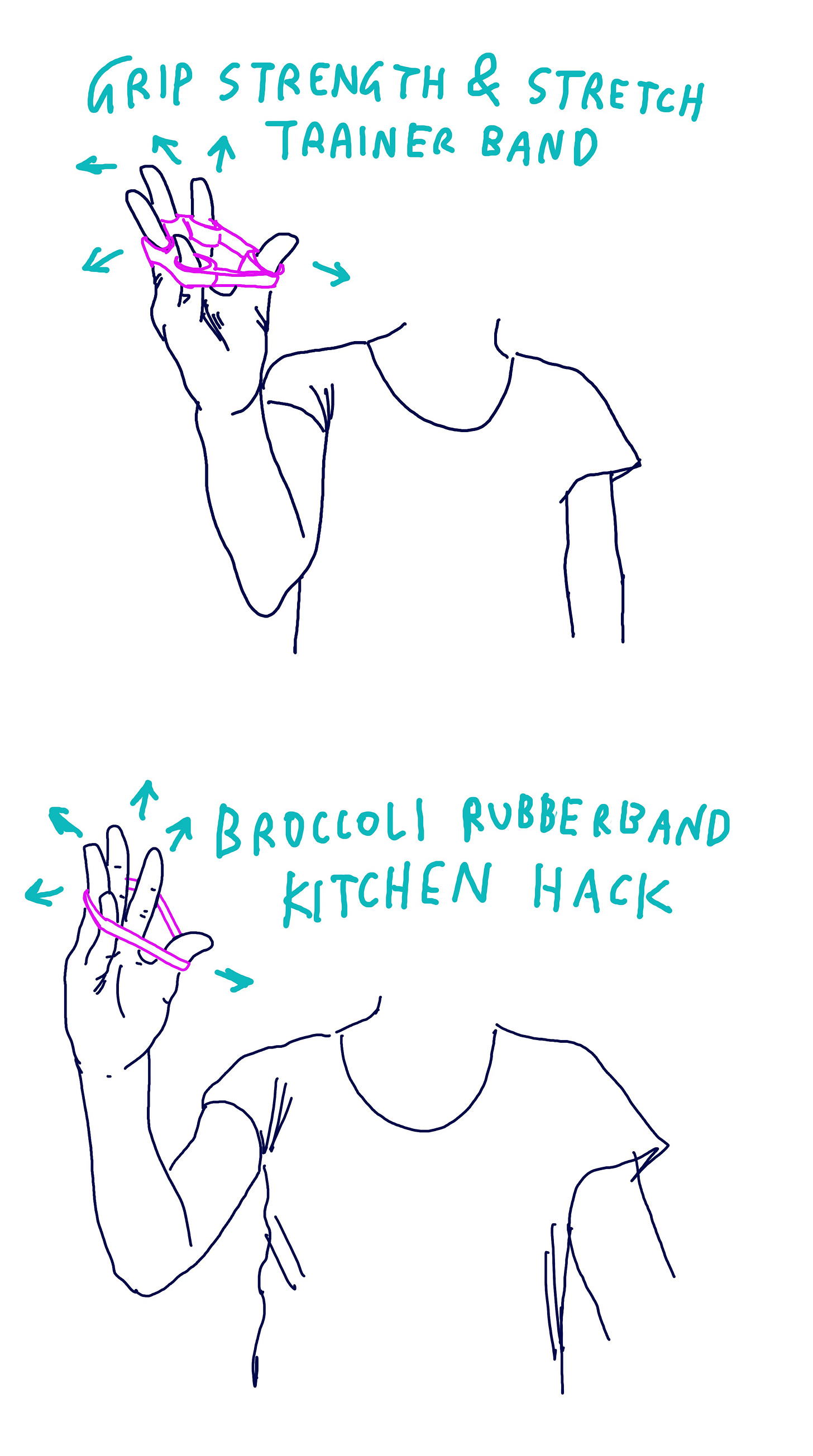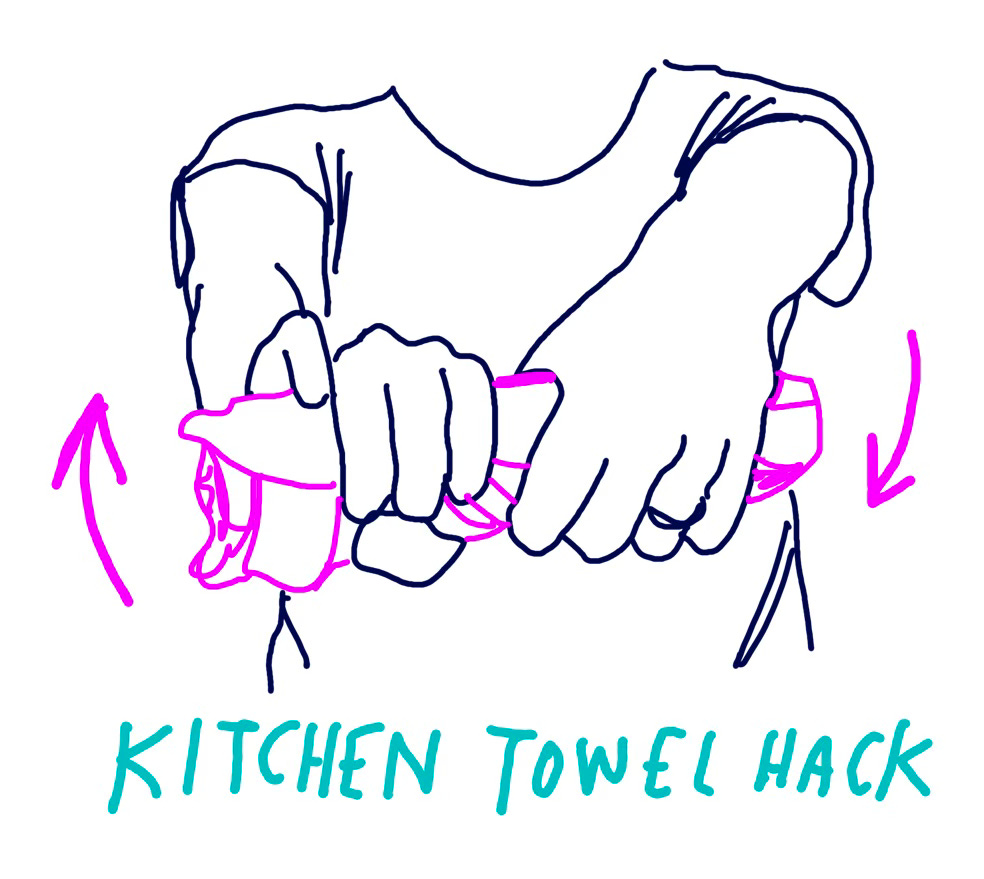Strength & Mobility for Artists
Tips and techniques to keep you drawing from Guest Artist Bonnie Tsui, author of On Muscle
Welcome, DrawTogether/GUT friends! So happy you’re here.
NEWS: DrawTogether at the de Young: 5/3
Exciting heads up: If you’re in the Bay Area on Saturday, May 3, I will be hosting an epic DrawTogether Strangers and more drawing adventures at the San Francisco’s de Young museum on Saturday, May 3. Here’s a little promo video the museum made:
I’m honored to be the 2025 featured artist at the de Young’s annual mega-event de Youngsters Day Out. The museum is going to be popping. In addition to hosting a full-on DrawTogether Strangers experience, I worked with the museum to create custom pencils and an art-treasure-hunt-sketchbook that we’ll give away so everyone can draw around the museum. And you can take a selfie with some of the DrawTogether Studio props in the de Young x DrawTogether photo booth!


Bring your young (at heart) friends, draw with me, sketch around the museum, and let’s take a verrrrry serious artist photo together. I’d love to see you there.
Back to the Body
Alright, last week’s exercise was a stretch and flex for all of us (har har.) Author of On Muscle Bonnie Tsui joined us to talk about the role of muscle in art, and went full body for our assignment. The results were fabulous!
Winner of our book giveaway is… Patrina A. Patrina, please write to community@drawtogether.studio to claim your copy of On Muscle!
And bonus: we have ONE MORE BOOK to give away to a subscriber this week, so be sure to share your drawings. Plus, if you’re in Southern California, catch Bonnie LIVE at a couple On Muscle events in Malibu (today 4/27) and West Hollywood (4/28)!
This week, we’re delighted to welcome Bonnie Tsui back to talk about the bodies of artists and how we as artists can care for ours. This is something people in the arts rarely talk about, and I’m hellbent on changing it. Folks, this one is personal.
Last year, I was diagnosed with severe degenerative hip arthritis. At some point in the next couple years I’m going to have to get a full hip replacement. Friends, I’m 49. how did this happen? I was surprised to learn from the doctors and physical therapists that the deterioration of the cartilage in my hip is due to two things: 1. the way my body was born. And 2: The way I sit while drawing.
For decades I’ve sat with my left heel propped up on the edge of my chair. (I am flexible.) The I lean forward, extending my body past my knee. It’s kind of like a sitting pigeon pose. I know, I know. But it felt good. Comfortable. And I had no idea I was doing damage to my body.
In art school, nobody teaches you to keep both feet on the ground while sitting. Or to sit up straight. (Did you know that’s one of the reasons an angled desk is so useful??) Or that we need to stretch our necks around regularly, stretch our forearms, rotate our wrists. Turns out, if we don’t learn this stuff early, we WILL learn it later. The hard way.
In an effort to interrupt possible worsening habits and help take care of our artist bodies, I asked Bonnie if she would give a little intro on how we can take care of our bodies as artists. She was delighted to help us out.
The Artist’s Body: How to Care for Ourselves
Bonnie knows a lot about this topic. In On Muscle, she talks about Michelangelo’s experience painting the Sistine Chapel and the impact on his own body:
The Last Judgment, it must be noted, was also a strikingly physical act of endurance for the aging artist himself, who climbed seven levels of scaffolding each day for five years. He even wrote a satirical sonnet about how miserable it was to paint the ceiling. “A goiter it seems I got from this backward craning . . . ,” he wrote. “From all this straining / my guts and my hambones tangle, pretty near.” In the margins of the poem, he sketched a bent figure contorting itself to paint shapes on the ceiling.

Making art is a physical act (among other things!) We artists frequently struggle with repetitive stress injuries. Our work can also involve toxic substances (though hopefully less often these days)! This is why getting back in touch with our body and using it as a tool in drawing is so important. I asked Bonnie a few questions about this:
Wendy: I love how you talked about muscles moving throughout the whole body, and our art has to come from our whole bodies as well. Our lives have gotten so small and crunched because of technology and how we hold it and focus on it. But that’s very constrictive. When I compare this to how artists have been trained to stand at easels — there’s the expression “drawing from the shoulder” — I think about needing to get back to a more expansive way of drawing and being. What can we do to get people to open back up and expand their bodies?
Bonnie: One way we can open back up is finding ways to stand and move. I have a standing desk that can move up and down. To be able to change from seated to standing, is part of what keeps our bodies healthy — as artists, it also changes our perspective.

Wendy: I was recently reading that one of the key aspects of resilience is flexibility and agility. If you want to draw in the long term, you need to be able to stand up and sit down, and move around. You know, as we develop an artistic practice, we also develop these habits that impact our body like sitting in a particular way. Those habits can either support our body and drawing habit or they can be to its detriment.
Bonnie: One of the most amazing qualities of muscle is its adaptability and ability to change. I love that about it, and what it says about us as people—that we’re capable of change, too. We’re always changing. It’s a philosophy of muscle that I want to live by.
Wendy: So by moving, that is building that change, that adaptability. It’s actually very common for people who draw to do physical therapy at some point because we haven’t been doing enough of that. It’s important for us to be thinking about our physical body and its well-being and also the more we’re aware of our body, the more we can use it in our drawing.
Bonnie, would you share some movements with us that we could do to care for our bodies?
Bonnie: I thought you’d never ask.
Three Movement Practices to Support Strength and Mobility for Drawing
1. Hand and Finger Strength and Mobility for Drawing
Many people have used stress balls or other things they squeeze, but those actually only promote movement in one direction! A really helpful stretcher allows for multiple movements and also gets your hand to expand. Bonnie is using a finger stretcher that offers resistance (you can find one at your favorite online retailer), but a good substitute is a thick rubber band, like the ones you find in the supermarket holding heads of broccoli.
2. Wrist, Arm, and Shoulder Strength and Mobility for Drawing
With a rubber cylinder or a rolled-up towel, you can twist it in alternating directions. You can start with smaller movements focused on the wrists and forearms, but you can also make the movements bigger through your shoulder and spine, through your core. This illustrates how we can expand from more restrictive movements! While a towel won’t feel quite the same as the cylinder (Bonnie’s is a Therabrand Flexbar), you should still be able to feel the stretch.
3. Whole Body Stretch and Strengthen for Drawing
That same towel can be used to stretch the whole body!
Bonnie likes to use a large resistance band/strap so she can lift her arms over her head and fully extend from a more contracted position and then lean side to side.
Give these a try and let us know how you feel.
HAVE A COMMENT OR QUESTION ABOUT STRENGTH AND MOBILITY FOR ARTISTS? LEAVE IT IN THE COMMENTS BELOW!
Alright, now let’s see how to apply these stretches and motions to our drawing practices - while drawing! This assignment is inspired by one of our heroes of movement: the magnificent Choreographer and Dancer and leader of New York Live Arts, and friend of DrawTogether, Bill T Jones.

Let’s get ready to draw using our bodies.
Assignment: Draw with The Whole Body
Keep reading with a 7-day free trial
Subscribe to DrawTogether with WendyMac to keep reading this post and get 7 days of free access to the full post archives.






